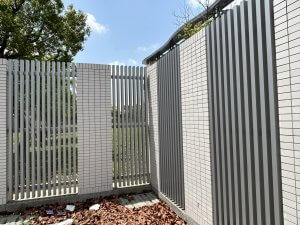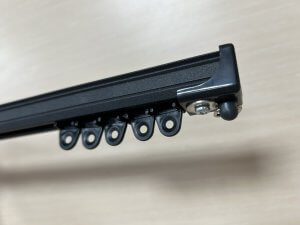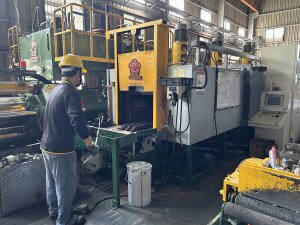What is an Aluminum Extrusion Grille? What is its Core Manufacturing Advantage?
In the architectural and interior design market, aluminum extrusion grilles have gradually become one of the top material choices for designers and construction professionals. They are not merely decorative elements, but advanced grille systems that combine aesthetics, functionality, and durability. They are widely used in ceiling designs, building façades, interior partitions, sunshades, ventilation panels, and other applications. Compared to traditional wooden, steel, or plastic grilles, aluminum extrusion grilles offer superior structural stability, better weather resistance, and greater design flexibility-making them particularly well-suited to Taiwan’s hot, humid, and typhoon-prone climate.
The core advantage of aluminum extrusion grilles lies in their aluminum extrusion manufacturing process. Aluminum alloy raw materials are heated to high temperatures and extruded through molds to form aluminum profiles with specific cross-sections and dimensions. These profiles are then subjected to surface treatments such as anodizing or powder coating, and finally assembled into grilles according to the design. This manufacturing method not only ensures precise dimensions but also guarantees structural strength and consistent appearance, meeting the high standards of architectural aesthetics and engineering requirements.
Aluminum extrusion grilles are commonly seen in shopping malls, office buildings, airports, high-speed rail stations, exhibition halls, and restaurants. Many high-end residences also adopt them to enhance both the interior and exterior spatial quality. They add depth and dimension to spaces while providing functions such as ventilation, daylight control, privacy screening, and even sound absorption. In the following sections, we will explore their features, manufacturing process, and advantages to give you a comprehensive understanding of this versatile building material.
Aluminum Extrusion Grilles – The Technology of Aluminum Alloy Extrusion
Primarily used in ceiling designs, exterior façades, sunshades, interior partitions, and ventilation décor, aluminum extrusion grilles consist of evenly spaced aluminum slats or panels. They are not only visually appealing but also serve functional purposes such as airflow, shading, and light control.
Their core advantage lies in aluminum extrusion technology-a process in which aluminum alloy is heated to a malleable state, then forced through a mold using a high-pressure extrusion press to form profiles with the desired cross-section. This process offers several key benefits:
-
Precision shaping – Molds can be designed for various cross-section shapes, ensuring uniform grille size, spacing, and appearance.
-
Structural stability – Extruded aluminum has high internal density and excellent strength, making it durable and resistant to deformation over time.
-
Customization flexibility – Profiles can be manufactured in different widths, thicknesses, colors, and surface finishes according to design needs.
-
High corrosion resistance – When combined with anodizing, powder coating, or electrophoretic coating, the grilles can effectively resist Taiwan’s humid and saline environment.
Aluminum extrusion processing allows grilles to surpass wood or steel in appearance, durability, and installation efficiency, making them a popular choice in modern Taiwanese architecture and interior design.
Features of Aluminum Extrusion Grilles
Aluminum extrusion grilles strike the perfect balance between appearance, functionality, and durability. Their main features can be summarized as follows:
-
Excellent weather and corrosion resistance
Taiwan’s climate is humid with high salt content-especially in coastal areas-causing many metal materials to rust or discolor. However, the natural oxide layer of aluminum effectively prevents corrosion. When enhanced with anodizing or powder coating, the grille can withstand UV exposure, acid rain, and harsh weather. In real-world applications, even after more than a decade of outdoor use, aluminum extrusion grilles can retain their color with minimal maintenance.
-
Lightweight yet strong
Aluminum’s density is about one-third that of steel, making it lightweight while retaining excellent structural rigidity. For suspended ceilings or high-altitude installations, this light weight improves safety during construction and reduces the structural load on the building. This is especially critical in large commercial spaces, exhibition halls, and airports.
-
Highly customizable shapes and dimensions
Aluminum extrusion can produce profiles with a wide range of cross-sections, including square tubes, round tubes, flat strips, T-shapes, U-shapes, and irregular designs. This flexibility allows designers to match various architectural styles—from modern minimalism to Japanese, industrial, or even luxurious aesthetics.
-
Diverse surface finishing options
Anodizing produces a matte metallic texture, while powder coating offers a variety of colors such as champagne gold, matte black, silver, and bronze. This makes the grilles both decorative and compatible with other materials in the space.
-
Safety and fire resistance
Aluminum extrusion grilles are non-combustible. In the event of a fire, they will not contribute to flames or release harmful gases, making them suitable for public buildings with strict fire safety regulations.
-
Low-maintenance
With smooth surfaces that resist dust accumulation, these grilles require only water or mild cleaners for upkeep—unlike wooden grilles that need regular sealing or painting and are prone to warping in humid environments.
aluminum extrusion grilles offer high durability, lightweight performance, safety, and design flexibility, making them an essential high-performance material in modern Taiwanese architecture.
The Manufacturing Process of Aluminum Extrusion Grilles
The production of aluminum extrusion grilles is a highly precise and specialized process, with each stage impacting the final quality and lifespan.
-
Selection of aluminum alloy raw materials
Taiwanese manufacturers commonly use 6063 and 6061 aluminum alloys due to their excellent formability, corrosion resistance, and attractive finish after anodizing. Of these, 6063 is most frequently used in architectural grilles for its fine surface texture and uniform color.
-
Heating and extrusion
Aluminum billets are heated to around 450°C – 500°C to achieve the optimal malleability, then forced through a mold opening using a high-pressure extrusion press to form profiles with the desired cross-section. The mold design is crucial, as it determines the grille’s shape and structural precision.
-
Cooling and stretching alignment
Extruded profiles are cooled immediately and then stretched to relieve internal stresses, ensuring they remain dimensionally stable during further processing and assembly.
-
Cutting and machining
Profiles are cut precisely to the required lengths, with additional processes such as drilling, chamfering, or edge polishing performed as needed for assembly and installation.
-
Surface treatment
- Anodizing: Improves corrosion resistance and creates a uniform oxide layer, with multiple color options.
- Powder coating: Uses electrostatic application of powder, cured at high temperature to provide rich colors and excellent wear resistance.
- Electrophoretic coating: Ensures a uniform finish and enhances corrosion and weather resistance.
-
Assembly and quality inspection
Finished profiles undergo pre-assembly testing to verify secure joints, accurate spacing, and flawless surfaces before being delivered for on-site installation.
Many high-end projects in Taiwan incorporate CNC precision cutting and automated coating systems to maintain consistent quality and production efficiency. This process not only enhances aesthetics but also ensures long-term stability and low maintenance costs.
Advantages of Aluminum Extrusion Grilles
The advantages of aluminum extrusion grilles stem from both their physical properties and precision manufacturing, offering dual benefits in functionality and aesthetics:
-
Aesthetic appeal and spatial depth
The linear arrangement of grilles creates rhythm and a sense of extended space. Designers can manipulate width, spacing, and color to produce unique atmospheres-such as matte black fine slats for modern minimalism or champagne gold bold frames for luxury malls.
-
Ventilation, lighting, and privacy
Grille structures allow airflow and natural light penetration while shielding from excessive sunlight and outside views. Outdoors, they function as sunshades; indoors, as semi-open partitions.
-
High installation efficiency
Most aluminum extrusion grilles are modular and pre-fabricated in factories, allowing rapid assembly on-site-a major advantage for commercial projects with tight schedules.
-
Durability and environmental sustainability
With a long lifespan and 100% recyclability, aluminum meets Taiwan’s green building material standards and helps reduce construction waste.
-
Low maintenance costs
Their dirt-resistant surface finishes are easy to clean, minimizing the need for frequent repairs or repainting-resulting in low long-term maintenance expenses.
-
Wide applicability
From shopping malls and airports to high-speed rail stations and luxury residences, aluminum extrusion grilles perform reliably in both indoor and outdoor settings.
Aluminum extrusion grilles combine durability, aesthetics, environmental friendliness, and design flexibility, making them ideal for Taiwan’s variable and humid climate. Whether for large public infrastructure or private home renovations, they deliver structural stability, safety, and a refined visual presence.
If you are planning a project that requires high-quality aluminum extrusion grilles—or wish to learn more about mold customization, co-extrusion, composite processing, or surface finishing—please contact 【Yuan-Cheng Aluminum Co., Ltd.,】for professional service.



contact us




